

2019 is bound to become one of the largest fire years on record in the Arctic Circle, and especially in Siberia. How much carbon these fires release remains a challenging question. Very little ground data on fire emissions is available for Siberia and estimations are difficult since the main part of the emissions originates from organic soils, which is harder to retrieve from satellite imagery than emissions from aboveground biomass. Our research team from the Vrije Universiteit Amsterdam (the Netherlands), Woods Hole Research Center, Northern Arizona University (USA), Pyrenean Institute of Ecology (Spain), and the Siberian Branch of the Russian Academy of Sciences and Tomsk State University (Russia) are joining forces to better understand fire dynamics in Siberia.
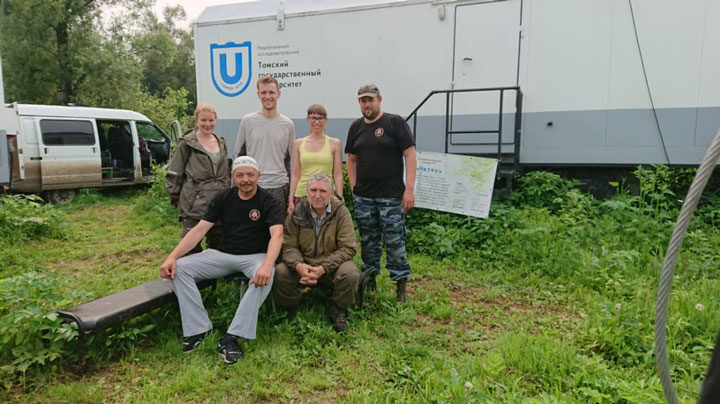
After an adventurous three-hour drive, our field crew gathered with the local collaborators at Kajbasovo Research Station near Tomsk, in Russia. We aimed at finding old pine trees in burned and unburned sites, which we then core with tree borers to build tree-ring chronologies. Wildfires in this western part of the Siberian boreal forest usually don’t burn with high intensity allowing some resilient trees to survive multiple fire cycles. Thus, we aimed at using the chronologies to reconstruct the fire history of the area and to assess the response and recovery times of the ecosystem after fire events and other disturbances.
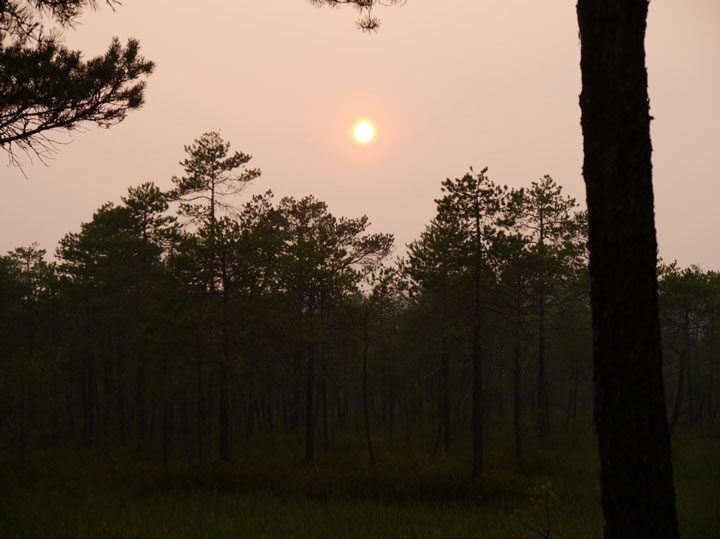
Little did we know that we would ourselves witness the severity of this year’s fire season. Except for the first day, we did not see a clear sky. From then on, the sun would only appear as a bright orange or blood red ball behind lots of smoke originating from wildfires in the Krasnoyarsk region hundreds of kilometers away. One good thing about this is that it dampened the heat, since we were already quite warmly dressed in our tick- and mosquito-proof clothing.
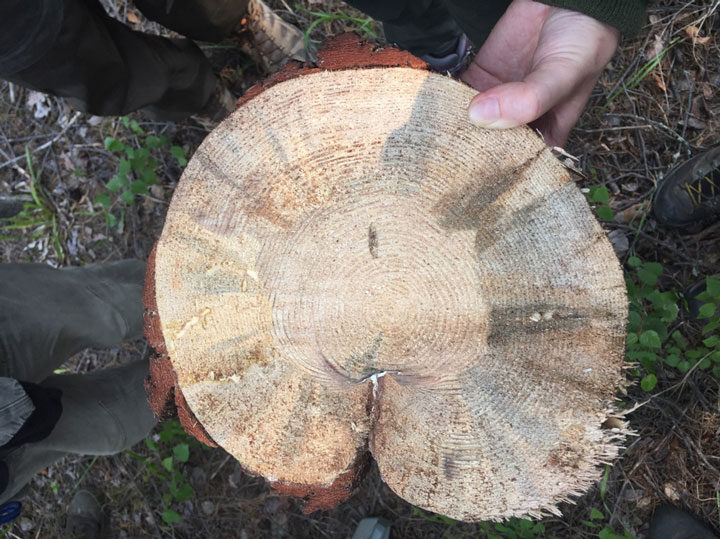
Mosquitoes and heat, however, were only small obstacles, as we set out with our borers to find trees older than 100 years. We really wanted trees from that age so that we can build sufficiently long chronologies. Even at the most remote places we were surprised to often see signs of human activity such as past logging, resin extraction or littering. One day we even saved a duckling out of a fisher net set up a good 4 hours bumpy drive away from the next village. Or sometimes we would simply not find old trees because of natural disturbances or growth restrictions. Eventually, we did manage to sample 12 sites with old trees with different fire severities and hydrologic characteristics. These will now be analysed further in the lab to extract and crossdate the tree rings.

Being in the field and having only very little time to sample can be an intense working experience, but there were many special little moments too. Our driver overcame every obstacle on the way to bring us to very remote places, and our cook took great care of us with plenty of delicious borscht, buckwheat and blinis (type of pancakes) and provided large amounts of water and kompot (sweet fruit beverage). And our evenings were spent at camp fires diving into local culture and connecting the people.
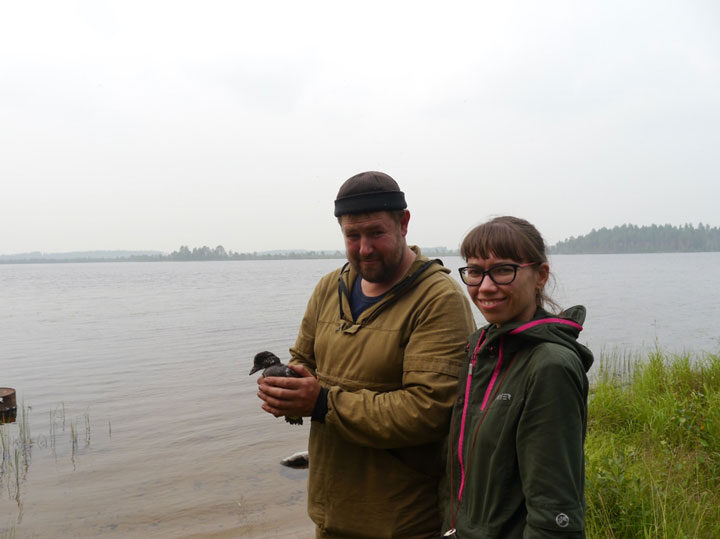
After ten exciting days in Tomsk we are now resting and recovering in Yakutsk for the weekend. We are using the time for some team building activities, and we are enjoying some solid hours of sleep. We went shopping for supplies for the second part of our field campaign, which will lead us to even more remote areas around the little villages of Ert and Batamay in the next four weeks. There, we will visit recently burned forests and measure the carbon losses due to fire events. In addition, we will take more tree chronologies to estimate the stand age, and count seedlings to see how forests recover after fires of different severities.
This field campaign is part of the ‘Fires pushing trees North’ project funded by the Netherlands Organisation for Scientific Research (NWO) and affiliated with NASA ABoVE. The Tomsk part of the campaign was funded by INTERACT.
This blog post was written by Rebecca Scholten, PhD student at Vrije Universiteit Amsterdam, researching arctic-boreal fire dynamics.
As part of our field work to measure carbon emissions in burned areas, we often have to hike through an obstacle course of fallen trees to reach our research sites. I took some video with a GoPro to give a sense of what this is like, as well as how we extract soil to take measurements and how we find the perfect sites.
Elizabeth Wiggins is a PhD student in the department of Earth System Science at the University of California, Irvine.
In the field, collecting the data is a big job – but our work starts long before we start taking measurements, with the task of finding desired sites within the landscape.

Jocelyne coring a tree to determine the age of the forest (Credit: Sander Veraverbeke)
As our time in Saskatchewan progresses, choosing and finding the right places to collect data becomes progressively more difficult. We are looking for a wide range of forest ages and species composition. This becomes more and more challenging as the time passes, since we now need to find sites with the particular characteristics that we are missing. To find these places, we look at maps that show when and where fires have occurred, and combine this information with maps from logging companies that show location and dates of timber projects.
Every day, we head out to several sites that we identified the night before. We usually drive an hour or so on gravel roads, and hike several hundred meters into the forest. We check for the right species composition at the site, and use a tool called a tree borer to extract a thin cylinder from a nearby tree trunk. From this tree core, we can count the number of rings and determine the approximate age of the forest. If the forest age and species composition meet our expectations, we finally begin our data collection. If not, we return to the car and attempt another location.
It can be challenging when we don’t find what we expected, which can result from inaccuracies in the map layers we use. At times this can be frustrating, but thanks to our team’s stamina, we always eventually manage to find what we need. With only a couple days left in the field, all the gaps in our data will soon be filled.
Jocelyne Laflamme is an undergraduate student in Wildlife Biology and Conservation at the University of Guelph in Canada.
Since our last post, our team has moved an hour south to the small village of Weyakwin, where the Philion fire burned last year. There is a lot of logging Weyakwin, and we are very interested in the interactions between fires and logging. We are comparing burned forests that grew back after people cut trees, to those that grew back after an earlier forest fire.
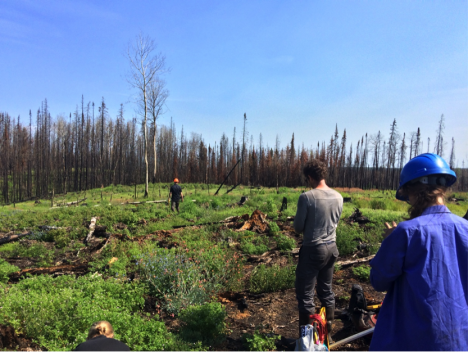
Sampling a young harvested site that burned last year. It was harvested only a year or two before it burned. (Credit: Solvik)
We believe there could be differences between the two in burn severity and the amount of carbon released by the fire. When a plot is harvested for lumber, the logs are removed but the soil remains. This is the opposite of burned areas, where fire burns into the soils but a lot of the trees remain standing, albeit charred. To study these differences, we are searching for areas of burn and harvest origin that are about the same age. We have seen some very young burned sites, many were less than 10 years old when they burned. This is surprising since forests in boreal regions typically burn when they are 50 to 100 years old. We were shocked to find a burned plot that had been harvested only a year or two earlier. Even without any significant trees or shrubs to carry the flames, the soil was able to sustain the fire.
At the sample sites, my job is to help characterize and quantify the aboveground biomass. This includes trees, shrubs, and dead trees that have fallen over, called “coarse woody debris.” I work with Brendan Rogers, our team leader, to measure every tree within a 2-by-30 meter sampling area. We identify the tree species, rate the amount of the canopy consumption, and measure the diameter. We will use these numbers to estimate how much carbon was released when that tree burned. Most of these tasks are fairly straightforward — although it can sometimes be tricky to differentiate between similar tree species after they have burned. We can measure individual trees pretty quickly, but it can still take one or even two hours to work through an entire site. At one site, we counted over 350 trees, measuring the diameter and estimating the canopy consumption for each and every one!
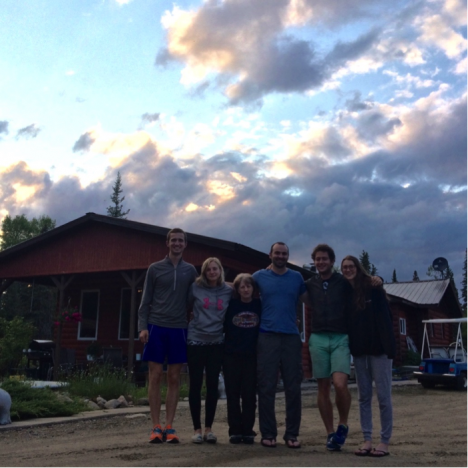
Our team and Rita. From left to right: Kylen Solvik, Liz Wiggins, Rita, Brendan Rogers, Sander Veraverbeke, and Jocelyne Laflamme. Missing: Catherine Dieleman, who had to fly home early for a friend’s wedding. (Credit: Solvik)
In Weyakwin, we are staying at a small bed & breakfast. Our host, a wonderful lady named Rita, takes great care of us. She cooks us breakfast and dinner, and she even packs us brown bag lunches for us to grab on our way out. After going out for dinner every night at our previous lodging in La Ronge, it has been a great change of pace eating home-cooked meals. We will be staying with Rita for the next week, and then we will be returning to Saskatoon to fly back to our respective homes. One of our team members, Catherine Dieleman, left early for her friend’s wedding. We will miss her and her soil expertise dearly.
But there are a lot more sites to sample before we are done!
Kylen Solvik is a research assistant at Woods Hole Research Center in Falmouth, Massachusetts.
One of the best parts of a field campaign are the ‘little moments’ that sneak in while you work. They can really make your day. On that front this field campaign has been no slouch. Yesterday for example, we saw a juvenile black bear while we were traveling to a new field site. We also enjoyed a great sunset over Lake La Ronge here in Saskatchewan, and had a beaver sighting later that evening.
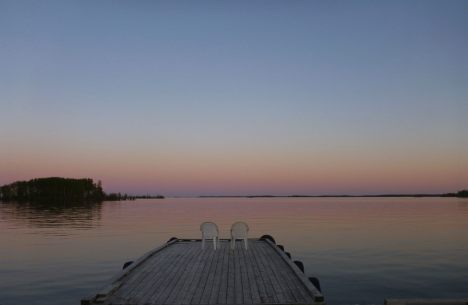
The great sunset the team enjoyed over Lake La Ronge on June 5. (Credit: Dieleman)
However, for me one of the best ‘little moments’ happened the day before… Our team is split into a number of different groups that measure different ecosystem characteristics: fire severity, tree density, species and age, as well as soil horizons and depth of burn in the soil. Liz Wiggins and myself work together to collect the soil measurements. As we measure and collect samples from every organic soil horizon, this task can take some time — often causing the soils group to finish up well after the rest of the team. Saturday though, everything came together for us soil diggers, and for the first time on this campaign our little group finished up first. We thought it was worth a victory photo. Sometimes it is the little things.
That Saturday was a particularly eventful day for the whole team. We had a great opportunity to participate in the filming of CBC’s The Nature of Things. Everyone was a pleasant combination of excited with a touch of nerves to be filmed, but generally thrilled to be sharing our science in this medium. The whole filming crew was wonderful, and eased us through the whole process. The sneak peek of the drone footage they shot seemed pretty promising to us, but we will all have to wait till 2017 to see the final footage. I guess some days in the field it is the big things too.
Catherine Dieleman is a post-doctoral researcher in Ecosystem Science at the University of Guelph in Ontario, Canada